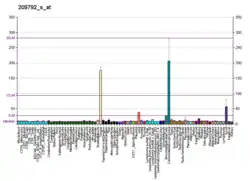KLK10
Kallikrein-10 is a protein that in humans is encoded by the KLK10 gene.[5][6][7][8][9]
| KLK10 | |||||||||||||||||||||||||||||||||||||||||||||||||||
|---|---|---|---|---|---|---|---|---|---|---|---|---|---|---|---|---|---|---|---|---|---|---|---|---|---|---|---|---|---|---|---|---|---|---|---|---|---|---|---|---|---|---|---|---|---|---|---|---|---|---|---|
| |||||||||||||||||||||||||||||||||||||||||||||||||||
| Identifiers | |||||||||||||||||||||||||||||||||||||||||||||||||||
| Aliases | KLK10, NES1, PRSSL1, kallikrein related peptidase 10 | ||||||||||||||||||||||||||||||||||||||||||||||||||
| External IDs | OMIM: 602673 MGI: 1916790 HomoloGene: 26428 GeneCards: KLK10 | ||||||||||||||||||||||||||||||||||||||||||||||||||
| |||||||||||||||||||||||||||||||||||||||||||||||||||
| |||||||||||||||||||||||||||||||||||||||||||||||||||
| |||||||||||||||||||||||||||||||||||||||||||||||||||
| |||||||||||||||||||||||||||||||||||||||||||||||||||
| |||||||||||||||||||||||||||||||||||||||||||||||||||
| Wikidata | |||||||||||||||||||||||||||||||||||||||||||||||||||
| |||||||||||||||||||||||||||||||||||||||||||||||||||
Kallikreins are a subgroup of serine proteases having diverse physiological functions. Growing evidence suggests that many kallikreins are implicated in carcinogenesis and some have potential as novel cancer and other disease biomarkers. This gene is one of the fifteen kallikrein subfamily members located in a cluster on chromosome 19. Its encoded protein is secreted and may play a role in suppression of tumorigenesis in breast and prostate cancers. Alternate splicing of this gene results in multiple transcript variants encoding the same protein.[9]
References
- GRCh38: Ensembl release 89: ENSG00000129451 - Ensembl, May 2017
- GRCm38: Ensembl release 89: ENSMUSG00000030693 - Ensembl, May 2017
- "Human PubMed Reference:". National Center for Biotechnology Information, U.S. National Library of Medicine.
- "Mouse PubMed Reference:". National Center for Biotechnology Information, U.S. National Library of Medicine.
- Liu XL, Wazer DE, Watanabe K, Band V (Sep 1996). "Identification of a novel serine protease-like gene, the expression of which is down-regulated during breast cancer progression". Cancer Res. 56 (14): 3371–9. PMID 8764136.
- Polikoff D, Kuo WL, Cochran JF, Wernick M, Kowbel D, Myambo K, Collins CC (Apr 1998). "Assignment of protease, serine-like 1 (PRSSL1) to human chromosome 19q13 by in situ hybridization and radiation hybrid mapping". Cytogenet Cell Genet. 79 (1–2): 147–8. doi:10.1159/000134705. PMID 9533035.
- Lundwall A, Band V, Blaber M, Clements JA, Courty Y, Diamandis EP, Fritz H, Lilja H, Malm J, Maltais LJ, Olsson AY, Petraki C, Scorilas A, Sotiropoulou G, Stenman UH, Stephan C, Talieri M, Yousef GM (Jun 2006). "A comprehensive nomenclature for serine proteases with homology to tissue kallikreins". Biol Chem. 387 (6): 637–41. doi:10.1515/BC.2006.082. PMID 16800724. S2CID 436200.
- Diamandis, Eleftherios P.; Deperthes, David; Lundwall, Åke (Jun 2006). "Proceedings of the 1st International Symposium on Kallikreins, Lausanne, Switzerland, September 1-3 , 2005". Biol Chem. 387 (6): 635–824. doi:10.1515/BC.2006.081. PMID 16800723. S2CID 83910246.
- "Entrez Gene: KLK10 kallikrein-related peptidase 10".
Further reading
- Diamandis EP, Yousef GM, Luo LY, et al. (2001). "The new human kallikrein gene family: implications in carcinogenesis". Trends Endocrinol. Metab. 11 (2): 54–60. doi:10.1016/S1043-2760(99)00225-8. PMID 10675891. S2CID 25806934.
- Zhang Y, Bhat I, Zeng M, et al. (2006). "Human kallikrein 10, a predictive marker for breast cancer". Biol. Chem. 387 (6): 715–21. doi:10.1515/BC.2006.090. PMID 16800732. S2CID 1962156.
- Bonaldo MF, Lennon G, Soares MB (1997). "Normalization and subtraction: two approaches to facilitate gene discovery". Genome Res. 6 (9): 791–806. doi:10.1101/gr.6.9.791. PMID 8889548.
- Luo L, Herbrick JA, Scherer SW, et al. (1998). "Structural characterization and mapping of the normal epithelial cell-specific 1 gene". Biochem. Biophys. Res. Commun. 247 (3): 580–6. doi:10.1006/bbrc.1998.8793. PMID 9647736.
- Goyal J, Smith KM, Cowan JM, et al. (1998). "The role for NES1 serine protease as a novel tumor suppressor". Cancer Res. 58 (21): 4782–6. PMID 9809976.
- Harvey TJ, Hooper JD, Myers SA, et al. (2001). "Tissue-specific expression patterns and fine mapping of the human kallikrein (KLK) locus on proximal 19q13.4". J. Biol. Chem. 275 (48): 37397–406. doi:10.1074/jbc.M004525200. PMID 10969073.
- Gan L, Lee I, Smith R, et al. (2001). "Sequencing and expression analysis of the serine protease gene cluster located in chromosome 19q13 region". Gene. 257 (1): 119–30. doi:10.1016/S0378-1119(00)00382-6. PMID 11054574.
- Dhar S, Bhargava R, Yunes M, et al. (2002). "Analysis of normal epithelial cell specific-1 (NES1)/kallikrein 10 mRNA expression by in situ hybridization, a novel marker for breast cancer". Clin. Cancer Res. 7 (11): 3393–8. PMID 11705853.
- Bharaj BB, Luo LY, Jung K, et al. (2002). "Identification of single nucleotide polymorphisms in the human kallikrein 10 (KLK10) gene and their association with prostate, breast, testicular, and ovarian cancers". Prostate. 51 (1): 35–41. doi:10.1002/pros.10076. PMID 11920956. S2CID 27003835.
- Luo LY, Diamandis EP, Look MP, et al. (2002). "Higher expression of human kallikrein 10 in breast cancer tissue predicts tamoxifen resistance". Br. J. Cancer. 86 (11): 1790–6. doi:10.1038/sj.bjc.6600323. PMC 2375391. PMID 12087468.
- Petraki CD, Karavana VN, Luo LY, Diamandis EP (2002). "Human kallikrein 10 expression in normal tissues by immunohistochemistry". J. Histochem. Cytochem. 50 (9): 1247–61. doi:10.1177/002215540205000912. PMID 12185203.
- Strausberg RL, Feingold EA, Grouse LH, et al. (2003). "Generation and initial analysis of more than 15,000 full-length human and mouse cDNA sequences". Proc. Natl. Acad. Sci. U.S.A. 99 (26): 16899–903. Bibcode:2002PNAS...9916899M. doi:10.1073/pnas.242603899. PMC 139241. PMID 12477932.
- Petraki CD, Gregorakis AK, Papanastasiou PA, et al. (2004). "Immunohistochemical localization of human kallikreins 6, 10 and 13 in benign and malignant prostatic tissues". Prostate Cancer Prostatic Dis. 6 (3): 223–7. doi:10.1038/sj.pcan.4500674. PMID 12970725.
- Sauter ER, Lininger J, Magklara A, et al. (2004). "Association of kallikrein expression in nipple aspirate fluid with breast cancer risk". Int. J. Cancer. 108 (4): 588–91. doi:10.1002/ijc.11607. PMID 14696124. S2CID 29116787.
- Diamandis EP, Scorilas A, Kishi T, et al. (2004). "Altered kallikrein 7 and 10 concentrations in cerebrospinal fluid of patients with Alzheimer's disease and frontotemporal dementia". Clin. Biochem. 37 (3): 230–7. doi:10.1016/j.clinbiochem.2003.11.012. PMID 14972646.
- Grimwood J, Gordon LA, Olsen A, et al. (2004). "The DNA sequence and biology of human chromosome 19". Nature. 428 (6982): 529–35. Bibcode:2004Natur.428..529G. doi:10.1038/nature02399. PMID 15057824.
- Gerhard DS, Wagner L, Feingold EA, et al. (2004). "The status, quality, and expansion of the NIH full-length cDNA project: the Mammalian Gene Collection (MGC)". Genome Res. 14 (10B): 2121–7. doi:10.1101/gr.2596504. PMC 528928. PMID 15489334.
This article is issued from Wikipedia. The text is licensed under Creative Commons - Attribution - Sharealike. Additional terms may apply for the media files.





